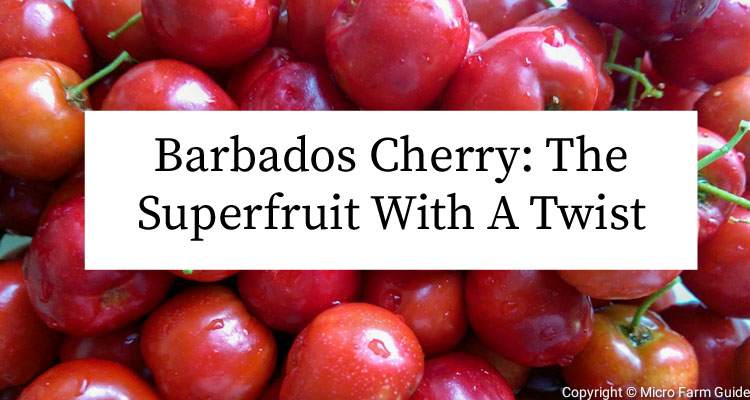Barbados Cherry, often called “Acerola,” is a captivating fruit that is unique and often misunderstood.
Not only is it unrelated to regular cherries you find in stores, but it actually has two scientific names.
Confused? Well, I don’t blame you… But there’s more!
Barbados Cherries are nutritional powerhouses, with Vitamin C levels far surpassing that of oranges…
Now, can you imagine what this can mean for your immune system? Exactly!
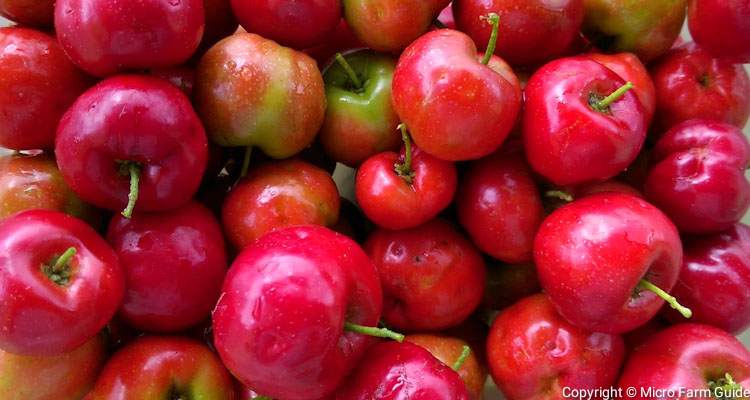
In this article, we’ll walk you through the unique world of Barbados Cherry, unveiling its origins, appearance, culinary uses, nutritional benefits, and more.
So, without further ado, let’s dig in!
What Are Barbados Cherries?
Barbados Cherries might look like regular cherries, but they’re not!
In fact, they come from a little shrub native to the Caribbean, Central America, and other tropical regions of North and South America.
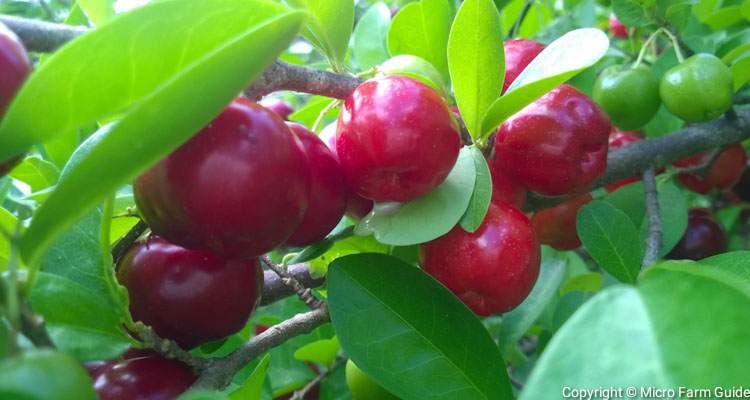
Remember I mentioned two names before?
Well, “Barbados Cherry” has two scientific names, Malpighia emarginata and Malpighia glabra.
Contrary to popular belief, they are not the same plant.
However, they are so similar in appearance, taste, and the fruit they produce that we use them interchangeably.
What Do Barbados Cherries Look Like?
The Barbados Cherry plant is a shrub with glossy green leaves, which vary in hue as they age.
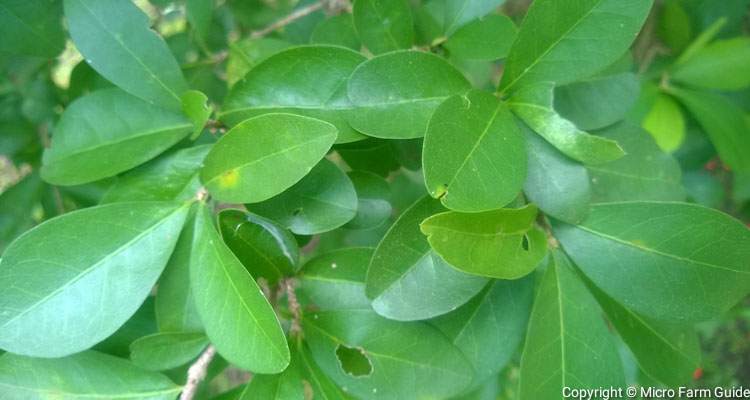
When given space, Barbados cherry trees can grow up to 20 feet tall but are usually kept shorter to make harvesting easier and might act as a decorative fence.
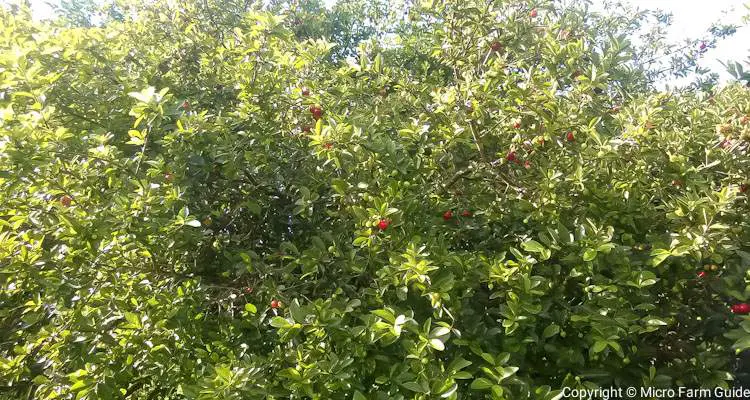
Barbados cherry trees produce beautiful tiny, pink flowers, which tend to grow in clumps.
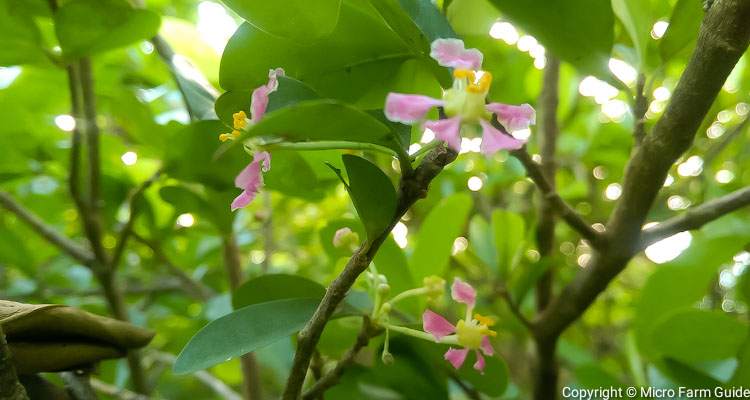
These lovely flowers later transform into tiny green fruit, which grow larger and change color to orange, red, and dark red as they ripen, resembling little jewels amidst the backdrop of the green leaves.
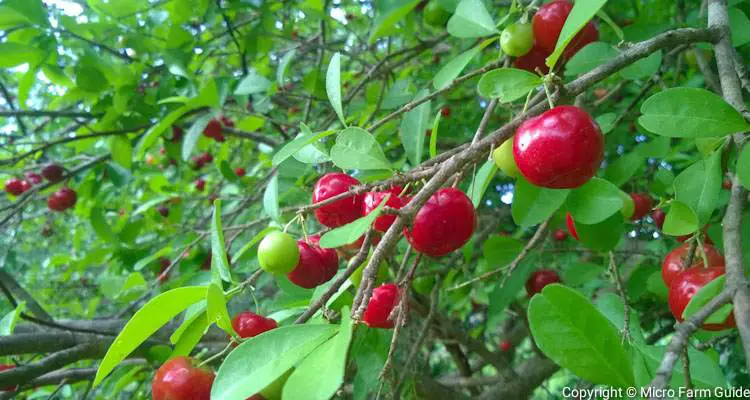
These fruits contain three seeds each, unlike the single pit of regular cherries.
That said, based on the variety, you will notice slight differences. For example, the leaves of Malpighia glabra tend to form clusters, while those of Malpighia emarginata are more evenly spaced.
How To Use Barbados Cherries
Barbados Cherries are not just for looking at. They are great to eat fresh or can be used to make juice, jams, syrup, or sauces.
They are often described as tasting tangy-sweet flavor, meaning they taste acidic, almost like a lemon.
Of the four mature trees we have, only one produces sweet cherries, and this is only when they are well-ripe and turn dark red.
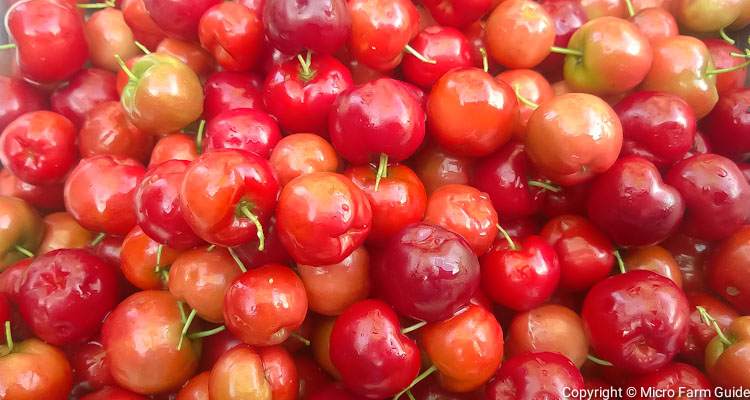
However, the acidity of the fruit is great for juices and jams. For example, I do not even have to add lemon when making Barbados Cherry Jam. Here’s the recipe I use.
Sour Cherry Jam (Recipe)
- 4 cups Barbados Cherries
- 1 Stick Cinnamon
- 1 cup Water
- Sugar
- Metal Strainer
Method:
1. Boil cherries and water until cherries are soft to be pureed with a fork.
2. Puree cherries by stirring with a fork to remove seeds.
3. Pour pureed cherries through a metal strainer to separate the pulp from the seeds.
4. Measure the pulp and add ¾ cup sugar to every 1 cup pulp. Add cinnamon and stir.
5. Heat uncovered content until it starts to boil and continue for at least 25 minutes, stirring often.
6. Monitor the liquid as you stir until it reaches the jam stage when the liquid starts to form a thick gel-like sheet on the spoon.
7. Remove from heat, cover, and allow to cool. Then, place the Jam into sterilized jars to cool further.
Barbados Cherry Jam tastes incredible, but I must admit it’s a sweet treat and does not carry over the nutritional benefits of the raw cherries. Let’s take a look at that now.
What Are The Nutritional Benefits Of Barbados Cherries?
Barbados Cherry is like a healthy supplement in fruit form.
It’s loaded with vitamin C, with each cherry providing about 80 mg or 89% of the amount of Vitamin C we require daily.
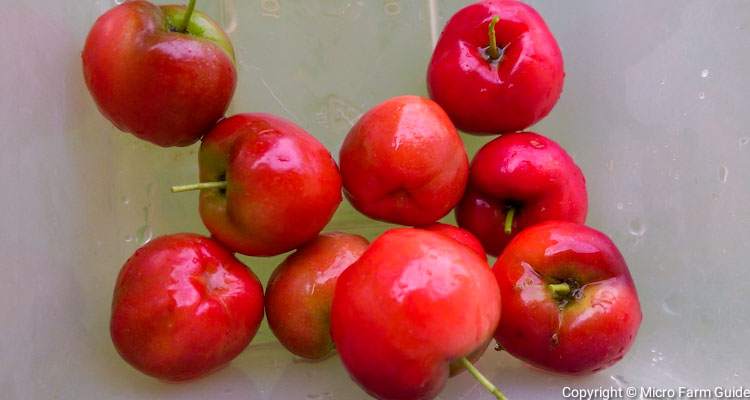
To put this into perspective, each cherry is typically less than one inch in diameter.
This means that we can easily consume 10 or more in one sitting, giving our immune system a boost and keeping us healthy.
Besides vitamin C, Barbados Cherry also contains Vitamin A and antioxidants, which can benefit your skin and eyes.
How To Grow Barbados Cherry Tree
Here is a simple way to grow Barbados cherry trees in your garden.
1. Choose A Suitable Location
First, Barbados Cherries love sunlight and can grow in various soil types. However, they prefer growing in moist, fertile, well-draining soil.
So, choose a suitable location and amend it with organic material if necessary.
2. Purchase Healthy Plants
Then, purchase a healthy grafted plant from a local nursery. These plants are usually hybrids, have predictable qualities, and will produce fruit much faster than growing from seed.
I usually grow my cherries from seeds. As a result, I can never be sure what to expect from the plant, except that they are well adapted to the climate in my region.
3. Plant Your Cherry Plants
Next, Dig a Hole about twice the width of the root ball and place the tree in it. Make sure it’s at the same depth as it was in the nursery pot.
Additionally, you can dig a second hole about twice as deep as the first, next to the tree, and fill this with organic material.
This will act as a compost pit and help to hold moisture and provide the plant with nutrients as it grows.
4. Care And Maintenance
Initially, you will have to water your Barbados Cherry trees regularly, especially during dry spells.
However, they will basically take care of themselves once established.
You can apply mulch, compost, or other natural fertilizers periodically, but there is no need for complicated fertilizer schedules.
Also, monitor for pests such as aphids, mealy bugs, and mites.
In most cases, the plant will be able to survive but be ready to act if necessary.
You can expect to harvest fruits between 2 to 5 years based on the method, variety, and age of the planting material you started with.
When Are Barbados Cherries Available?
Barbados cherries are available year-round in most tropical regions, provided they receive suitable growing conditions.
For example, in order to fruit, Barbados cherries need a mix of warm temperatures, bright sunlight, moisture in the soil, and enough nutrients.
If the weather is unusually wet or dry, this can halt production temporarily until they receive suitable conditions.
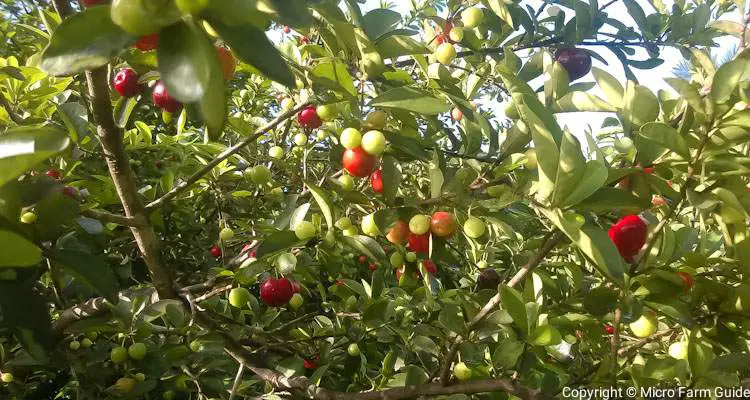
That said, this does not mean you’ll always see fruits on the tree. Instead, the tree flowers and produces all fruits within 3 to 4 weeks. Then flowers again, sometimes taking a month or two break.
This is the case with my trees, which has been producing fruits almost non-stop for the last two years. And as I am writing, this is laden with ripe fruit while flowering again.
This constant fruit production is excellent, except Barbados cherries last briefly once ripe, whether on the tree or harvested.
How to Preserve And Store Cherries?
Barbados Cherries have a short shelf life once picked, so preserving them is crucial in enjoying them year-round.
As mentioned, one way to keep their deliciousness intact is by making homemade jams. It’s a sweet way to make your harvest last.
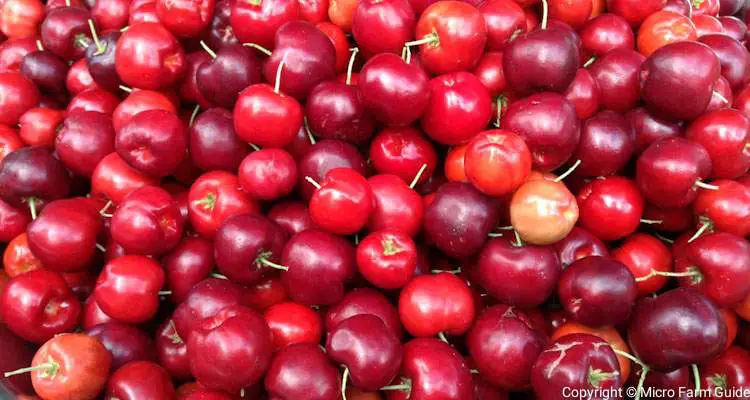
You can also store them in the refrigerator for short-term storage, about a week at most, before they begin to spoil.
However, the best way to store Barbados Cherries long term is to freeze them.
To do this:
- Wash the cherries after harvesting
- Allow them to air dry in a cool area for a short time.
- Place them in plastic bags and then into the freezer.
Freezing ensures they remain fresh and delicious when you’re ready to enjoy them again.
By washing them first, you can use them without waiting for them to thaw out too much, which would put them at risk of spoiling.
Final Thoughts
Thank you for taking the time to read this article about Barbados Cherries!
We hope you’ve discovered something fascinating about this wonderful fruit.
From its citrus-like flavor to its unrivaled vitamin C content, Barbados Cherry is not just a fruit but a unique experience.
If you’ve discovered something fascinating and are eager to learn about other unique plants, check out our Plant Guide Page.
There’s a lot more to discover in the green world of nature! Enjoy!
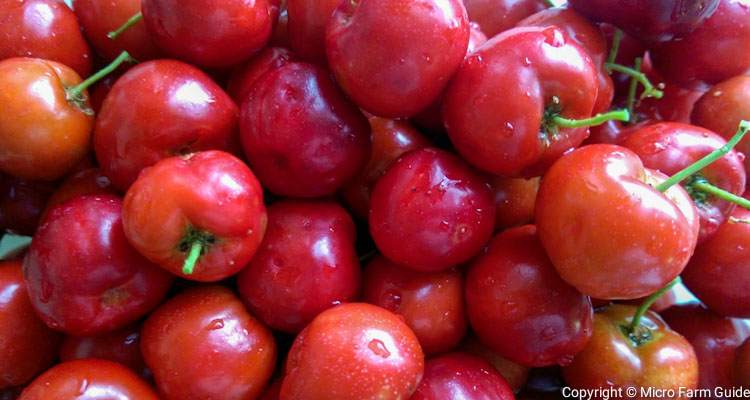
Related Questions
1. Can you eat Barbados Cherries?
Yes, you can eat Barbados cherries fresh or as an ingredient in jams, smoothies, etc. It is delicious and safe to consume unless you have a fruit allergy.
2. What is Barbados Cherry good for?
Barbados cherries are jam-packed with Vitamins C, minerals, and other beneficial compounds known to boost the immune system, contributing to an overall healthy body.
3. How does Barbados Cherry taste?
Barbados cherries have a range of flavors from sour-acid to sweet, sometimes on the same tree. The flavor differs based on variety, ripeness, and time of year.
4. Do Barbados Cherries taste like regular cherries?
No, Barbados cherries taste different from regular cherries. They are considered tart-sweet, with a citrus-like flavor.
References
American Botanical Council. Acerola Malpighia emarginata, M. glabra. herbalgram.org. Accessed November 2023
IFAS Extension. Malpighia Glabra – Barbados Cherry. ifas.ufl.edu. Accessed November 2023
Purdue University. Barbados Cherry Malpighia punicifolia L. Malpighia glabra Millsp. hort.purdue.edu. Accessed November 2023
Science Direct. Acerola juice – The Richest Known Source Of Vitamin C: A Clinical Study In Infants. sciencedirect.com. Accessed November 2023
NutritionValue. Acerola – West Indian Cherries. nutritionvalue.org. Accessed November 2023

